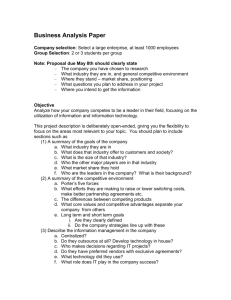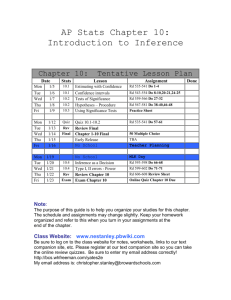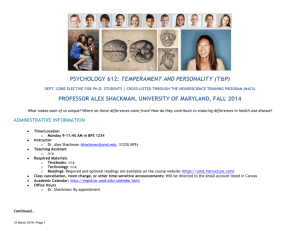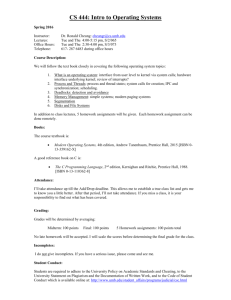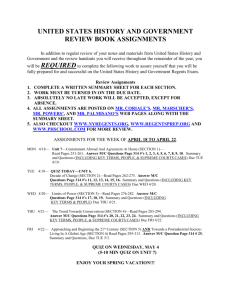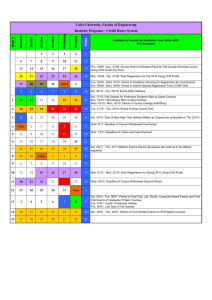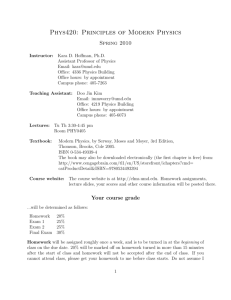- ShackmanLab
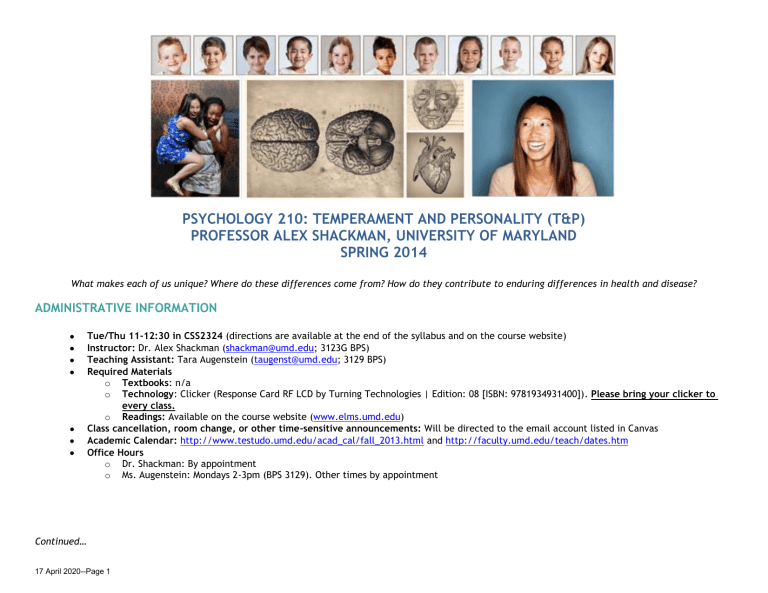
PSYCHOLOGY 210: TEMPERAMENT AND PERSONALITY (T&P)
PROFESSOR ALEX SHACKMAN, UNIVERSITY OF MARYLAND
SPRING 2014
What makes each of us unique? Where do these differences come from? How do they contribute to enduring differences in health and disease?
ADMINISTRATIVE INFORMATION
Tue/Thu 11-12:30 in CSS2324 (directions are available at the end of the syllabus and on the course website)
Instructor: Dr. Alex Shackman ( shackman@umd.edu
; 3123G BPS)
Teaching Assistant: Tara Augenstein ( taugenst@umd.edu
; 3129 BPS)
Required Materials o Textbooks: n/a o Technology: Clicker (Response Card RF LCD by Turning Technologies | Edition: 08 [ISBN: 9781934931400]). Please bring your clicker to
every class. o Readings: Available on the course website ( www.elms.umd.edu
)
Class cancellation, room change, or other time-sensitive announcements: Will be directed to the email account listed in Canvas
Academic Calendar: http://www.testudo.umd.edu/acad_cal/fall_2013.html
and http://faculty.umd.edu/teach/dates.htm
Office Hours o Dr. Shackman: By appointment o Ms. Augenstein: Mondays 2-3pm (BPS 3129). Other times by appointment
Continued…
17 April 2020--Page 1
COURSE OVERVIEW
Welcome! This course will introduce students to a diverse array of theoretical and empirical issues related to the study of stable individual differences in temperament and personality (T&P). We will discuss recent research in humans and nonhuman animals that helps to clarify
The childhood origins of temperament
The fundamental dimensions of personality across the lifespan
The psychological and neurobiological mechanisms that underlie differences in T&P
The mechanisms that contribute to stability and change in T&P across the lifespan
The strengths and limitations of different tools for assaying T&P
Implications for mental health and other important outcomes, including wealth, divorce, and incarceration
The information in this document is designed to help you understand how the course works and to get you started. If you have any questions, please contact the instructor or the TA. We’re excited to have you aboard and want you to get the most out of this opportunity to learn more about the science of individual differences!
A MULTI-DISCIPLINARY PERSPECTIVE ON THE CONTEMPORARY SCIENCE OF T&P
As we begin our adventure, it’s helpful to keep the following idea firmly in mind:
When a scientist doesn’t know the answer to a problem, he is ignorant. When he has a hunch as to what the result is, he is uncertain. And when he is pretty damn sure of what the result is going to be, he is still in some doubt…Scientific knowledge is a body of statements of varying degrees of certainty—some most unsure, some nearly sure, but none absolutely certain.
—Richard Feynman (1955), Nobel Laureate
Science is not a body of facts established by experts, but a set of methods for estimating and reducing uncertainty; a process, at times messy or tedious, of grappling with nature and our preconceived notions about how it works. There are many, many fundamental questions about T&P that remain unresolved.
That’s one of the things that make this class so enjoyable. We haven’t figured it out and there are many challenges that remain for future research.
Accordingly, in this class you will learn about the current state of our scientific knowledge about facets of T&P, their organization in the brain, and the implications for understanding psychopathology and other important outcomes. You will also learn about some of the key techniques used for measuring and understanding facets of T&P. But we will not review the scientific history of personality research (e.g., Freud).
In general, my emphasis will be on a multi-disciplinary perspective, in which research at different levels of analysis, using different tools, samples, or species, is viewed as complementary and mutually informative. Put another way, the class will not be organized around “biological theories,” “psychoanalytic theories,” and so on.
17 April 2020--Page 2
COURSE STRUCTURE
1. Classroom Lectures on the Scientific Study of T&P
You are strongly encouraged to attend all course lectures led by Professor Shackman or the Teaching Assistant. Each lecture will last approximately 90 minutes and will include the following components:
(1) Brief cumulative review of material covered in prior lectures (approximately 10-15 minutes). Many of the questions that will be featured on the exams will be covered during this period. For more details, see the section on Clickers, below.
(2) Conceptual roadmap outlining the new topics to be covered
(3) The science of T&P drawn from your readings and other sources. The lectures will incorporate occasional multimedia elements, such as film clips.
There will be plenty of time for questions and discussion. The lectures are designed to provide a broad overview of the core conceptual themes, methodological issues, as well as highlights from the empirical record.
(4) Recap of the most important take-home points
(5) Critical take-home questions (detailed below).
On occasion, we will have special invited guest lectures. It is critical that you regularly attend class in order to do well in this course. Although lecture slides may be posted online, critical take-home questions will not be posted online. We strongly encourage you take notes during class to ensure comprehension of the material. It is important to emphasize that there are many opportunities for us to learn from one another in the classroom. Learning can stem from sharing knowledge or from asking questions.
2. Background Readings
Readings for this course have been hand-picked by the instructor; many are original empirical papers or reviews by leading scientists in the field. What better way is there to learn about T&P then straight from the most exciting researchers working in the field today?
To get the most out of this course, it is important that you understand the readings. Please read the assigned papers before class that week. This will allow for a better understanding of the lecture and also give you the opportunity to ask questions. Please do not hesitate to ask questions about anything you found confusing or challenging! Readings will be available for download via the course website on Canvas.
Continued…
17 April 2020--Page 3
COURSE REQUIREMENTS & GRADING
1. Three Cumulative Examinations (30% each x 3 exams = 90% total grade)
There will be three cumulative exams in this course. The first two exams will occur during the regular academic semester. The final exam will occur during final examination week. Exams may consist of multiple-choice and short-answer questions that involve critical thinking about concepts drawn from the readings and lectures. The purpose of the exams is two-fold. First, you should be able to demonstrate that you have read the material and understand the factual points and arguments. Second, you should be able to synthesize and integrate the material such that this knowledge can be applied in a broader context.
Exams will take place in class on the assigned date in the syllabus and will be open book and note. Make-up exams will only be considered in exceptional circumstances. Make-up exams will involve different questions than the standard exam (Advice: you want to avoid having to take a make-up exam).
There will be exam review sessions before each exam (outside of class), in which the TA will be present to review the relevant material and address any questions.
It is important to emphasize that much of what is covered in the exams is not contained in the lecture slides, so attendance and attention during class is critical to your success on the exams.
2. Take-Home Questions (20 submitted questions x 0.5% each = 10% total grade)
At the end of each lecture, beginning during the second week of class (i.e., the 3rd meeting), you will receive two critical thinking take-home questions.
You will be required to respond to the critical thinking questions for 20 in-class lectures. You will not be required to respond to critical thinking questions during the first week of class (i.e., Lectures 1 and 2.1). On occasion, there will not be a critical thinking question for a particular class, as there are more than
20 classroom meetings each semester.
Responses will be assigned one of the following grades: 1 (full credit), 1⁄2 (half-credit), 0 (no credit). Grades will be made available in Canvas. Unexcused late responses will be assigned a score of 0. At the end of the semester, your two lowest response grades will be dropped.
Each assignment will consist of your response to 2 questions: 1 focused on the material described during the lecture and 1 focused on an aspect of the assigned reading that was not highlighted in the accompanying lecture. Your response should be approximately 1 paragraph per question (i.e., total of 2 separate paragraphs). Responses are due no later than 9:00am EST before the subsequent lecture (i.e., questions provided in class Tuesday are due by 9:00am Thursday that week; questions provided in class Thursday are due by 9:00am Tuesday the following week).
You will submit your responses using using the “assignment” tab in Canvas. Submissions should be uploaded as a Word document (.doc or .docx). The document should be single-spaced, 12-pt font, Times New Roman. Responses should include 2 components (with each component clearly labeled using headers). Length should range between ½ to 1 page single-spaced for both questions:
• Part I. Lecture question: The 1st part includes a 1-paragraph single-spaced response to Critical Thinking Question 1 focused on the lecture content. The paragraph response should be preceded by the header “Part I: Lecture critical question” above the written response. Please include the question itself prior to your response paragraph.
• Part II. Reading question: The 2nd part includes a 1-paragraph single-spaced response to Critical Thinking Question 2 covering reading content. The paragraph response should be preceded by the header “Part II: Reading critical question” above the written response. Again, please include the question itself prior to your response paragraph.
17 April 2020--Page 4
3. Extra Credit
Four points of extra credit will be available to students who complete the Department Mass Survey using the SONA system (see below for details).
NO STAKES IN-CLASS ASSESSMENTS: USING THE CLICKERS
Lectures will often begin with brief cumulative review of material covered in prior lectures (approximately 10-15 minutes). Many of the questions that will be featured on the exams will be covered during this period. Often, these “no stakes” (i.e., ungraded) assessments will require a clicker, so be certain that you consistently bring your clicker to class, register it, and have some spare batteries on hand. See http://clickers.umd.edu
for details on how to register your clicker as well as technical support.
SCHEDULE
Please check the course website for the most up-to-date information.
Date
Jan 28
Day #
Tue 1 None
Readings Comments
Jan 30 Thu 2
Topic
Introduction
Fundamental questions roundtable
Course mechanics
Expert perspectives video demos with discussion
The impact of T&P
Feb 4
Feb 6
Feb 11
Feb 13
Feb 18
Tue 3
Thu 4
The fundamental dimensions of T&P / Continuity and change in T&P
Measuring T&P
Tue 5.1 How are traits (T&P) and states related, 1?
Thu . Snow Day / Class Canceled
Tue 5.2 How are traits (T&P) and
states related, 2?
Required
Moffitt et al. PNAS 2011
Duckworth PNAS 2011 [commentary on Moffitt]
Moffitt et al. Amer Sci 2013 [popular press summary of Moffitt]
Optional
Lahey Amer Psychol 2009
Required
Caspi et al. Ann Rev Psychol 2005 [skip sections on Behavioral
Genetics & Social Development]
Optional
Kagan Encyclopedia on Early Childhood Development 2005
Required
Block Psychol Bull 1995
Tomarken Psychol Assessment 1995
Required
Chap 4 in Matthews, Deary & Whiteman (2009) [pp. 85-89 as well as pp. 107-end]
Required
Fox et al PlosOne 2008 [don’t worry about the technical details]
Canli et al PNAS 2006 [don’t worry about the technical details; focus on phasic vs. tonic models]
At the start of class, we will test the clickers. Please bring your clicker to class.
We will also collect a brief anonymous questionnaire measure of T&P for use in subsequent classroom demos.
Assignment of 1 st critical thinking questions at the end of the lecture.
17 April 2020--Page 5
Feb 20
Feb 25
Feb 27
Mar 4
Mar 6
Mar 11
Mar 13
Thu
Tue
6
7.1
/
7.2
What do individual differences in T&P do? How might they influence risk and resilience?
I. Endophenotypes and biomarkers
II. What You Can and Can’t
You Do with ERP & fMRI
Required
Davidson Cog and Emo 1998 [read Sections I and II only]
Gable, Reis & Elliot JPSP 2000 [don’t worry about the technical details]
Optional
Schuyler et al SCAN 2012 [don’t worry about technical details]
I. Required
Miller Ann Rev Clin Psychol 2013
II. Required
Pledger eRadImaging 2010
II. Optional
Glover Neurosurgery Clin North Amer 2011
Logothetis Nature 2008 [do not worry about the fine details]
Wager et al. 2008 [first 14 pages]
Thu -
Tue -
Exam Review
Exam #1
Thu 8.1 How is T&P related to mental disorders? Focus on
Neuroticism/Negative
Emotionality (N/NE)
Tue
Thu
8.2
9
How is T&P related to mental disorders? Focus on
Behavioral Inhibition
Role of the extended amygdala in N/NE, BI, and psychopathology
Required
Barlow et al Clin Psychol Sci 2013
Lahey Amer Psychol 2009
Optional
Ormel et al Clin Psychol Rev 2013
Required
NY Times Magazine article on behavioral inhibition
Fox et al Ann Rev Psychol 2005
Clauss & Blackford J Amer Acad Child & Adol Psychiatry 2013
[don’t worry about the technical details]
Optional
Kagan et al. Science 1988
Schwartz et al. Science 2003
Case J Amer Acad Child & Adol Psychiatry 2013
Blackford & Clauss J Amer Acad Child & Adol Psychiatry 2013
Required
Blackford & Pine Child & Adolesc Psychiatric Clin N Amer 2012
Feinstein et al Curr Biol 2011
Kalin et al J Neuroscience 2004 [don’t worry about the technical details]
Optional
Davis & Whalen Mol Psychiatry 2001
Adolphs et al Nature 1998
Choi & Kim PNAS 2010
No Class / Spring Break Mar 18
Mar 20
Mar 25
Mar 27
Apr 1
Tue 10.1 The nature & nurture of T&P and psychiatric disease, 1
Thu No Class
Tue 10.2 The nature & nurture of T&P and psychiatric disease, 2
Required
Visscher et al Nat Rev Genetics 2008
Kendler Mol Psychiatry 2013 [focus on the metaphors of the broken glass and the jet mechanic]
Optional
Flint & Kendler Neuron 2014
Required
Caspi Amer J Psychiatry 2010
17 April 2020--Page 6
Apr 3
Apr 8
Apr 10
Apr 15
Apr 17
Apr 22
Apr 24
Apr 29
May 1
May 6
May 8
Thu 10.3 The nature & nurture of T&P and psychiatric disease, 3
Tue Exam Review
Thu
Tue 11
Exam #2
Special guest lecture:
Electrophysiological approaches to understanding normal and disordered self-control
(Professor Ed Bernat)
Thu 12.1 Splitting broad-band N/NE into its constituents, 1
Caspi & Moffitt Nat Rev Neuro 2006
Optional
Monroe Psychol Sci 2008
Dick Ann Rev Clin Psychol 2011
Required
Bogdan et al. Mol Psychiatry 2013
Hughes Nature 2014
Exam Review
Exam #2
Required
Hutchison Ann Rev Clin Psychol 2010
Optional
Bernat et al J Abnormal Psychol 2011
Tue
Thu 13.1 Special guest lecture:
Extraversion/Positive
Emotionality (E/PE) 1:
Foundations (Professor Matt
Roesch)
Tue .
Thu 14
Sick Day
Special guest lecture:
Psychopathy (Tara
Augenstein)
Tue 13.2 Extraversion/Positive
Emotionality (E/PE) 2A:
Biological Bases and Role in
Depression
Thu
Tue
12.2
13.3
17
Splitting broad-band N/NE into its constituents, 2
Extraversion/Positive
Emotionality (E/PE) and Self-
Control 2B: Biological Bases and Role in Substance Use and other Impulsive
Disorders
Recap of semester
Required
Grupe & Nitschke Nat Rev Neurosci 2013
MacLeod & Mathews Ann Rev Clin Psychol 2012
Lissek Dep and Anx 2012
Lissek et al. Behav Res & Ther 2005 [don’t worry about the technical details]
Required
Shackman et al Nature Rev Neurosci 2011 [don’t worry about the technical details]
Cavanagh & Shackman under review [don’t worry about the technical details]
Required
Wallis Nature Rev Neurosci 2007 n/a
None
Required
None
Optional
Kringelbach & Berridge Sci American 2012
Treadway & Zald Curr Directions Psychol Sci 2013
Pizzagalli Ann Rev Clin Psychol 2014
Berridge & Robinson Brain Res Rev 1998
Knutson & Greer Philo Trans Royal Soc B 2008
Required
None
Optional
Hare et al Science 2009
Belcher et al Trends in Cog Sci 2014
Knutson & Greer Philo Trans Royal Soc B 2008
Berridge & Robinson Brain Res Rev 1998
Fineberg et al CNS Spectrums 2014
May 13
17 April 2020--Page 7
(fundamental questions revisited) and exam review
May 15-21 No Class / Final Examination (Time / Location TBA)
Please note: This schedule is subject to change. Any required updates will be announced in class and posted on the course website. All readings are available on the course website.
TIPS FOR DECIPHERING THE ASSIGNED PAPERS
Here are some helpful tips to keep in mind as you read the assigned papers. Most of these apply equally well to review or empirical papers.
First Steps o Begin by reviewing the title of the article. The title will usually provide the central focus of the paper. o Next, read the abstract. The abstract will provide an overview of the study’s main research question, goals, and results. Don’t worry too much about the details or get hung up, just try to get a sense of the big picture.
Introduction o The introduction typically describes what the author hoped to achieve and states the problem being investigated. Normally, the introduction summarizes relevant research to provide context, and explain what other authors' findings, if any, are being challenged or extended. It should also describe or at least foreshadow the experiment, the hypothesis(es) and the general experimental design or method. o Aims?
What were the aims of the paper? It can sometimes even be helpful to highlight the main study goals and hypotheses as you are reading the introduction. This will allow you to easily reference the aims as you dig deeper into the methods, results, and conclusions.
If a review paper, what was the scope of the review? In other words, what are the authors trying to accomplish? o Background & Significance?
What is at stake? Why is this line of research worthwhile or important? Are the goals important or trivial? Often, the larger significance of the work is highlighted at the beginning of the Introduction (and the end of the Discussion).
Method and Participants? o I do not expect students to fully understand every operational detail or technique. But it is important that students do their best to understand the gist of what was done. o What did the authors do? Are the methods a good fit for the aims or is there a gap of some sort? o Who participated and how were they enrolled in the study? o How representative is the sample? Is it a good fit for the aims or does it limit the conclusions that can be drawn from the study?
Key results? o Did the results support the hypotheses?
Discussion o The purpose of the Discussion is put the findings in the context of prior literature, acknowledge limitations of the current study, and suggest specific implications for future research and applications to prevention, intervention, or policy. o Often, the first paragraph of the Discussion summarizes the key results o Often, the final paragraph of the Discussion summarizes the broad implications o In between, the authors usually discuss the meaning and implications of the results as well as key limitations o Implications?
What are the implications for our understanding of T&P?
What are the main implications of the findings for theory and for practice?
Are there broader implications for our daily lives? o Limitations/Caveats, stated or otherwise?
Provide strong evidence for the stated conclusions?
17 April 2020--Page 8
Are the claims convincing? If not, what further evidence is needed? Are there other experiments or work that would strengthen the paper further?
Were important aspects of T&P neglected in the paper? o Future challenges
What are the most profitable, impactful future steps?
HOW TO COMPLETE THE EXTRA CREDIT ASSIGNMENT USING SONA
Four points of extra credit will be available to students who complete the Department Mass Survey using the SONA system (see below for details).
1.
Create an account at http://ter.ps/SONAsignup . Please take care to enter your contact information correctly (i.e., errors = no extra credit)
2.
Choose PSYC 210 as the course (incorrect course = no extra credit)
3.
Earn extra credit by completing the “Mass Survey Spring 2014 Questionnaire” - a collection of on-line surveys, many designed to assess facets of T&P.
Please note that separate versions of the Mass Survey are available for students who are above or below 18 years of age (owing to different procedures for obtaining consent). The earlier you complete the Mass Testing Questionnaire the better. If you encounter difficulties, please contact the TA. Be prepared to describe the problem in as much detail as possible.
ADDITIONAL COURSE POLICIES
Students are responsible for making themselves aware of the relevant course and University policies. Some of these are described below.
Late Policy
Students will lose 10% of total possible points for each day late without prior approval (barring compelling reasons). Prior approval requires at least 48 hours advance notice.
Grade Disputes
In the case of disputed grades, students are required to submit a written claim within 48 hours of receiving the disputed grade that describes the disputed item/grade, rationale for altering the grade, and suggested alteration.
Curving
Your grade will be determined by your individual performance on the exams and written response exercises. The course will not be graded on a curve. With the exception of calculation errors, no changes will be made to your final grade at the end of the semester. If earning a particular grade is important to you, please speak with Professor Shackman or the TA at the beginning of the semester so that we can offer some helpful suggestions for achieving your goal.
Final Grade for the Course
Final grades will be assigned in accord with University policy, outlined below. Grades will be rounded up to the nearest 10 th of a point.
Letter Points
A+ 4.0
A
A-
B+
B
4.0
3.7
3.3
3.0 denotes excellent mastery of the subject and outstanding scholarship. denotes good mastery of the subject and good scholarship.
17 April 2020--Page 9
B-
C+
C
C-
D+
D
2.7
2.3
2.0
1.7 denotes acceptable mastery of the subject and the usual achievement expected.
D-
F
1.3
1.0
0.7
0 denotes borderline understanding of the subject. These grades denote marginal performance. denotes failure to understand the subject and unsatisfactory performance.
XF-denotes failure due to academic dishonesty.
W indicates withdrawal from a course in which the student was enrolled at the end of the schedule adjustment period. This mark is not used in any computation of quality points or cumulative average totals at the end of the semester.
Course Evaluations
You will have a formal opportunity to evaluate the effectiveness of this course, although I first want to encourage you to schedule a meeting with me
(Professor Shackman) or the TA if you have any questions, concerns, or suggestions for how we can help support your learning and engagement. Specifically, the University will ask you to evaluate all of your courses through the online system ( www.courseevalum.umd.edu
) at the end of the semester. As members of the campus learning community your feedback is crucial to the success of our program and therefore to the value of your degree. All I ask is that in evaluating of all your courses you approach it in the same way that you expect instructors to evaluate your performance: be open, honest, and objective.
Academic Integrity
Academic integrity is the foundation of science and the policies will be strictly enforced. Any indication of academic dishonesty (including but not limited to cheating, plagiarism and falsification) will be referred to the Office of Student Conduct ( www.osc.umd.edu
) without hesitation. You are responsible for reviewing the Department of Psychology’s policy statement on academic integrity ( http://psychology.umd.edu/aboutus/documents/documents/Syllabus_Supplement_on_Ethics_of_Scholarhip_in_Psychology.pdf
) for details and definitions.
The University of Maryland has a nationally recognized Code of Academic Integrity, administered by the Student Honor Council. This Code sets standards for academic integrity at Maryland for all undergraduate and graduate students. As a student, you are responsible for upholding these standards for this course.
It is very important for you to be aware that the consequence for cheating, fabrication, facilitation, and plagiarism in this class is a grade of “F”. For more information on the Code of Academic Integrity or the Student Honor Council, please visit: http://www.studenthonorcouncil.umd.edu/whatis.html
. The student-administered Honor Code and Honor Pledge prohibits students from cheating on exams, plagiarizing papers, submitting the same paper for credit in two courses without authorization, buying papers, submitting fraudulent documents and forging signatures. On every examination, paper or other academic exercise not specifically exempted by the instructor, students must write by hand and sign the following pledge: I pledge on my honor that I have not given or
received any unauthorized assistance on this examination (or assignment). Compliance with the code is administered by the Student Honor Council, which strives to promote a community of trust on the College Park campus. Allegations of academic dishonesty should be reported directly to the Honor Council (301-
314-8450) by any member of the campus community. For additional information, consult the Office of Student Conduct. For a description of the University's definition of academic dishonesty, suggestions on how to prevent cheating, and practical answers to frequently asked questions about the Code of Academic
Integrity, consult the Student Honor Council's webpage and click on the faculty tab.
Accommodations for Disabilities
The campus's Disability Support Service Office (DSS) works with students and faculty to address a variety of issues ranging from test anxiety to physical and psychological disabilities. If an instructor believes that a student may have a disability, DSS should be consulted (4-7682 or dissup@umd.edu). Note that to receive accommodations, students must first have their disabilities documented by DSS. The office then prepares an Accommodation Letter for course
17 April 2020--Page 10
instructors regarding needed accommodations. Students are responsible for presenting this letter to their instructors by the end of the drop/add period
( www.counseling.umd.edu/DSS ).
Religious Observances
Students will not be penalized because of observances of religious beliefs. Please note that it is your responsibility to notify the instructor by email ASAP regarding any absences for religious observances.
Electronic Devices
I expect you to make the responsible and respectful decision to refrain from the temptation to use your cell phone or other mobile electronic devices, such as tablets and notebook computers in class. If you have critical communication to attend to, please excuse yourself from the room and return when you are finished. If I find myself or other students to be distracted by your behavior, I may ask you to leave the room.
Inclement Weather or Campus Emergency
If the University is closed due to inclement weather or a campus emergency (you can find this out by looking at the campus website http://www.umd.edu
or the snow phone line (301-405-SNOW), classroom activities will be cancelled.
Learning Assistance Center
If you are experiencing difficulties in keeping up with the academic demands of this course, you are strongly encouraged to contact the Learning Assistance
Service (www.counseling.umd.edu/LAS). Their educational counselors can help with time management, reading, math learning skills, note-taking and exam preparation skills. All their services are free to UM students.
Students in Distress
Services for students in various forms of distress are offered by the Counseling Center and the Mental Health Service in the Health Center. During evenings and weekends, the student peer-counseling hotline (4-HELP or 4-4357) is available. Faculty who wish to consult with professionals may call 4-7651 for immediate assistance. For non-emergency issues, faculty can call the Warmline (4-7653). A therapist will respond within a few hours.
17 April 2020--Page 11
Continued…
ABOUT THE INSTRUCTORS
Professor Alex Shackman
Professor Shackman received his Ph.D. in Biological Psychology with a distributed minor in Neuroscience from the University of Wisconsin—Madison in 2008. His graduate research was supported by the National Science Foundation and National Institute of Mental Health. He subsequently conducted postdoctoral research in the laboratories of Richard Davidson, Brad Postle, and Ned Kalin in the Departments of Psychology and Psychiatry at Wisconsin. This work has appeared in a number of outlets, including the Proceedings of the National Academy of Sciences USA, Nature Reviews Neuroscience, Journal of Neuroscience, and Psychological Science. Professor Shackman serves as an Associate Journal Editor at Cognitive, Affective & Behavioral Neuroscience (CABN); ognition and
Emotion; Emotion; Frontiers in Human Neuroscience.
Dr. Shackman's major research interests include affective and cognitive neuroscience; neural bases of threat processing, anxiety, fear, and their application to anxiety, mood, and related psychiatric disorders; neural bases of personality; individual differences in anxiety and behavioral inhibition; cognition × emotion interactions: interactions of anxiety and higher cognition (cognitive control, selective attention, and working memory); developmental psychopathology; amygdala; anterior cingulate cortex (ACC); prefrontal cortex (PFC).
Key methods used by the Shackman lab include multimodal neuroimaging (fMRI, PET, VBM); peripheral physiological techniques (cortisol, facial EMG, fearpotentiated startle), and behavioral assays (eyetracking and experience sampling). Populations of interest include children, adolescents, healthy adults, and psychiatric patients.
To learn more about the lab, please visit our website at http://shackmanlab.org
Tara Augenstein
Ms. Augenstein is currently a second year graduate student in the Clinical Psychology doctoral program. Her research interests include the assessment of severe psychopathology and self-injurious behavior in children and adolescents. She is particularly interested in the development of novel approaches for the early identification and assessment of maladaptive behavior in youth.
To learn more her work, please visit the lab website at https://sites.google.com/site/caipumaryland/Home
DIRECTIONS TO THE CLASSROOM
17 April 2020--Page 12
